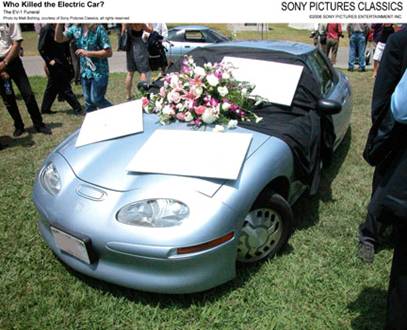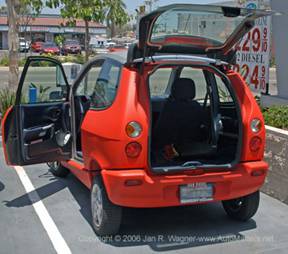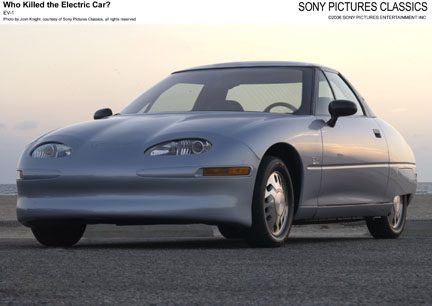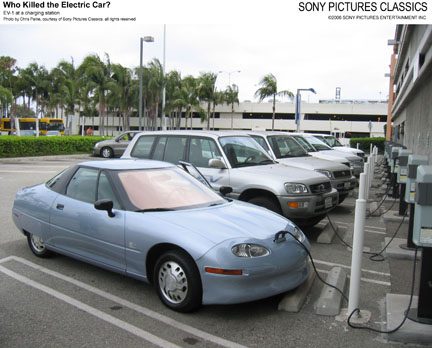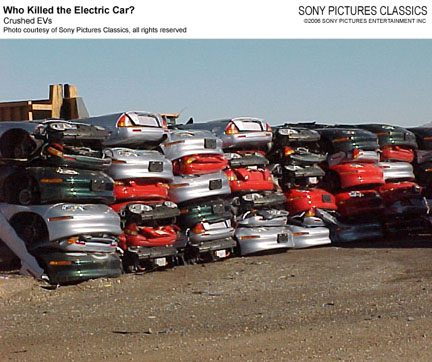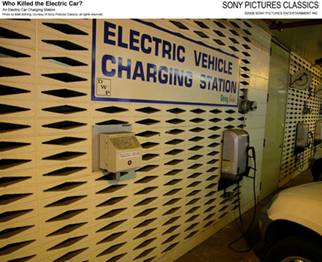
Who Killed the Electric Car?
A very thought-provoking film is making the rounds in theaters. Its title is “Who Killed the Electric Car? (www.sonyclassics.com/whokilledtheelectriccar).
While it mentions other electric vehicles too, like the Think – “An enterprise of Ford Motor Company,” it primarily chronicles the short life of the General Motors EV1.
This is not just a story about another discontinued car model. This is far more serious, and may have very long-ranging economic and environmental effects. Here is why, according to what I learned in the film and in its very thick Press Kit.
In 1990 the smog in the greater Los Angeles had become a critically serious problem that was endangering the health of the population. Fortunately General Motors, among others, had been working on cleaner forms of vehicle propulsion to address this growing problem.
The Impact concept electric car, which was later called the EV1, was introduced by General Motors at the Los Angeles Auto Show in 1990. Its zero emissions technology attracted the attention of the California Air Resources Board (CARB). They mandated a gradually increasing percentage of these zero emissions vehicles (ZEVs), beginning with a modest 2% market share in 1998. Faced with a government mandate in a state that sells large numbers of vehicles, the auto manufacturers seemingly had no choice but to prepare to build them.
However, while that work was going on, groups like The American Automobile Manufacturing Association were fighting for repeal of the CARB ZEV program. They would ultimately be successful.
In December of 1996 the GM EV1 came to market – but for lease, not for sale. I drove one once. It was an amazing vehicle, featuring futuristic good looks, sports car acceleration and the mind-boggling characteristic of never needing to stop at gas stations.
To refuel it with electricity, you just conveniently plugged it in when you went home at night and again when you reached your destinations during the day. While the range was much more limited than gasoline-powered cars, it still met the needs of many drivers. Furthermore, much better battery technology was being engineered and introduced to address this shortcoming.
GM had apparently lost interest in the EV1 by 2000. It had recently bought the Hummer brand name (remember, SUVs are very profitable). In 2001 it began laying off its EV1 sales team. In 2002, GM, DaimlerChrysler and others sued CARB to repeal the ZEV mandate. Later that year the US Department of Justice came out in support of the lawsuit against CARB.
The pressure was too much for one state to fight. CARB modified its mandate to allow manufacturers to meet it with other types of vehicles, which effectively doomed the electric car.
GM told drivers that they had to return their EV1s when their leases expired. Many EV1 drivers made a unified appeal to GM to sell them their cars, but GM would not do so. Instead the cars were taken back and crushed.
Oil has just reached $77 per barrel. Gasoline is over $3.00 per gallon in the U.S. We are being forced to make serious lifestyle changes because of this. Furthermore, automakers are finding that their SUV cash cows – once sources of great profits, are now sitting in increasing numbers on dealer lots. Highly fuel efficient cars are apparently not nearly as profitable, so the auto manufacturers must certainly be feeling the financial hit, too.
Oil company profits are at all time highs. If left unchecked, the higher gas prices go, the greater their profits will be so what incentives do oil companies have to lessen our “addiction” to oil until it runs out – unless they can find some other commodity that they can sell to us for a similar profit?
As the movie reminds us, gasoline-powered vehicles need costly, regular service to replace all sorts of consumables and wear items – including oil, filters, belts and hoses. This is a steady source of ongoing profits for car companies that sharply decreased for the electric cars.
Fuel cell vehicles are many years from the market and even if they do make it they may have serious shortcomings. They will require a new or highly modified infrastructure – a means to sell and deliver the hydrogen needed to fuel them. Perhaps there will be something established similar to what we have now with gas stations and, once again, we will have to pay whatever it costs, no matter how expensive it is. Also, the cars’ systems will be very complex, which may mean expensive regular maintenance.
The movie suggests that electric vehicles make more sense. In the same amount of time needed to bring these hydrogen-fueled vehicles to market, significantly better batteries could continue to be developed for electric cars that could be recharged at home and at recharging stations that have already been built.
So, who killed the electric car? Since we all have a stake in transportation, I strongly urge you to go see this important movie and answer that question yourself. It starts in San Diego at Landmark’s Hillcrest cinemas on July 21. If you’re like me you may leave the theater shaking your head in disgust.
Drive safely and do join me again next time.

